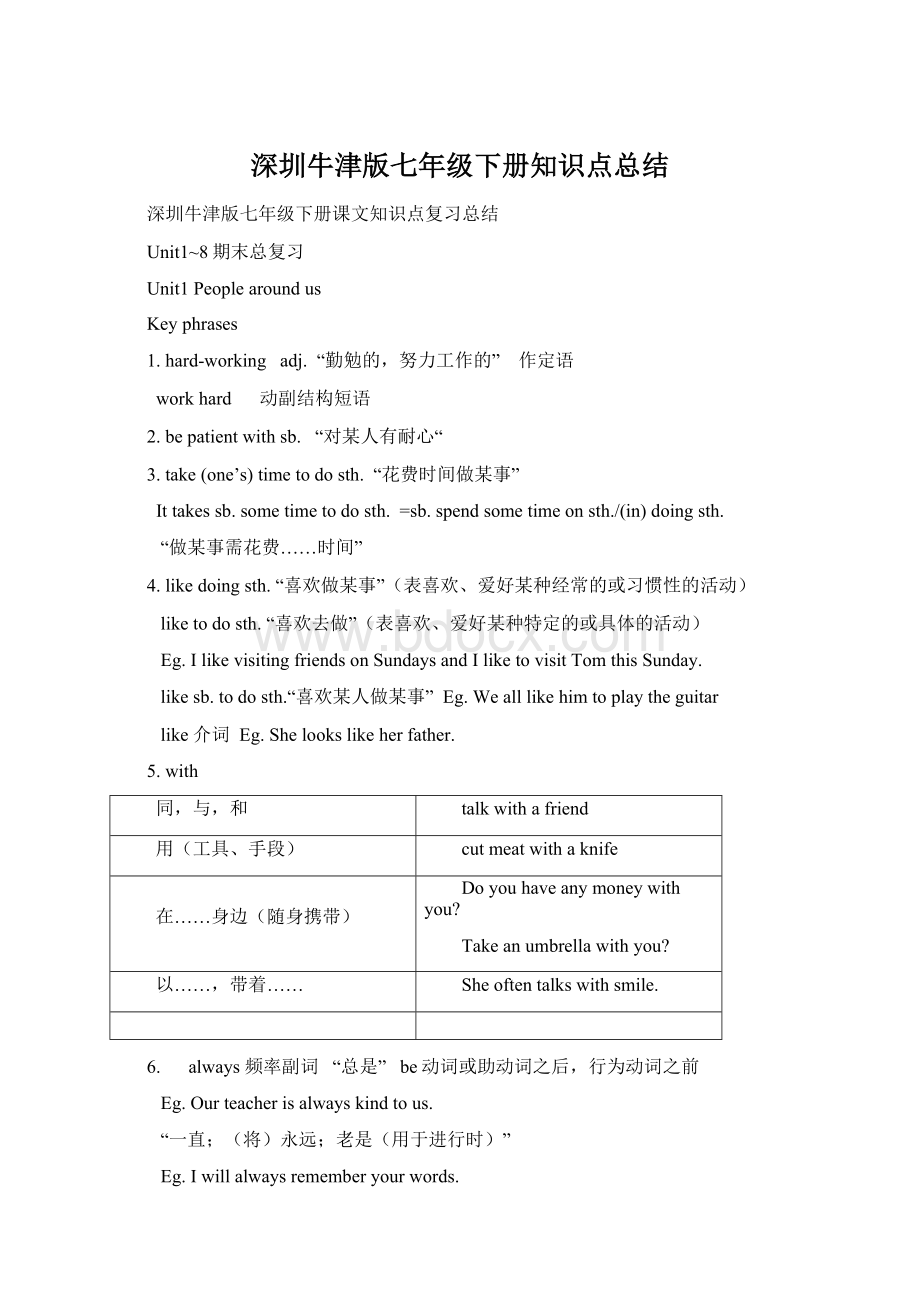深圳牛津版七年级下册知识点总结.docx
《深圳牛津版七年级下册知识点总结.docx》由会员分享,可在线阅读,更多相关《深圳牛津版七年级下册知识点总结.docx(55页珍藏版)》请在冰豆网上搜索。

深圳牛津版七年级下册知识点总结
深圳牛津版七年级下册课文知识点复习总结
Unit1~8期末总复习
Unit1Peoplearoundus
Keyphrases
1.hard-working adj. “勤勉的,努力工作的” 作定语
workhard 动副结构短语
2.bepatientwithsb. “对某人有耐心“
3.take(one’s)timetodosth. “花费时间做某事”
Ittakessb.sometimetodosth. =sb.spendsometimeonsth./(in)doingsth.
“做某事需花费……时间”
4.likedoingsth.“喜欢做某事”(表喜欢、爱好某种经常的或习惯性的活动)
liketodosth.“喜欢去做”(表喜欢、爱好某种特定的或具体的活动)
Eg.IlikevisitingfriendsonSundaysandIliketovisitTomthisSunday.
likesb.todosth.“喜欢某人做某事” Eg.Wealllikehimtoplaytheguitar
like介词 Eg.Shelookslikeherfather.
5.with
同,与,和
talkwithafriend
用(工具、手段)
cutmeatwithaknife
在……身边(随身携带)
Doyouhaveanymoneywithyou?
Takeanumbrellawithyou?
以……,带着……
Sheoftentalkswithsmile.
6. always频率副词 “总是” be动词或助动词之后,行为动词之前
Eg.Ourteacherisalwayskindtous.
“一直;(将)永远;老是(用于进行时)”
Eg.Iwillalwaysrememberyourwords.
Sheisalwaysmovingthingsaround.
Hehasalwaysbeenthetutor.
always>usually>often
7. probably adv. “大概;很可能”
adj. “可能的,大概”
Eg.I’llprobablybeadoctorinthefuture.
Itisprobabletofinishthejobbeforedark.
8. intheworld 世界上
allovertheworld=throughouttheworld 全世界
9. never adv.是ever的否定形式,用于加强否定语气。
位于be动词或助动词后,行为动词前;语气比not强。
反义词always
not adv. “没有,不”——表示否定,用在助动词或情态动词后
no adv. adj. “没有的;不许的;一点也没有;不”——用于否定回答
nothing 不定代词 “没有动词;没有事情”
Eg.Weneveruseit.
Idon’tknow.
It’snousedoingit.
Ihavenothingforyou.
10. aswell 副词短语,位于句尾,有时与连词and或but搭配使用。
“也,又,还有,同样的” 同义词:
also,too
Eg.HespeaksEnglishandSpanishaswell
=HespeaksEnglishandhespeaksSpanish,too.
=HespeaksEnglishandhealsospeaksSpanish.
Heisaworkerandapoetaswell.
too adv.——一般位于句尾或插入语放在句中,只用于肯定句,口语中与also通用
also adv.——用在句中,一般放在be动词或助动词之后,行为动词之前
aswellas 用作介词“还有,不但……而且……”
在AaswellasB的结构中,语意重点在A,不在B。
Eg.Hethinkstheotherwayisbetter.Ido,too.
HealsolikesEnglish.=HelikesEnglish,too.
HecanspeakSpanishaswellasEnglish.
11. takecareof=lookafter 照顾,照看
12. misssb.verymuch 非常想念某人
miss用作动词时,还有“漏掉,错过(机会);丢掉”
13. tomakemelaugh
makefunof=laughat 取笑……,嘲弄……
14. makeastudyof=study
makesb./sth.+形容词(作宾补),“使……怎么样”
Eg.Itmademehappy.
Wearedoingourbesttomakeourcountrymorebeautiful.
makesb.Dosth. 使某人做某事
Eg.Hisjokesmadeusalllaugh.
15. begoodat 擅长……=dowellin 在某方面做的好 反义表达:
bepoorat
Eg.HeisgoodatJapanese.=HedoeswellinJapanese.
Theyareverygoodatplayingfootball.=Theydoverywellinplayingfootball.
16. remain 作系动词后接名词或形容词 “一直保持,仍然(处于某种状态)”
17. befullof 充满…… 与befilledwith
adj. V.
Thebasketisfilledwithapples.=Thebasketisfullofapples.
18. bestrictaboutsth. 对某事要求严格
bestrictwithsb. 对某人要求严格
bestrictinsth./doingsth. 在(做)某事上要求严格
Eg.Ourteacherisalwaysstrictwithus.
Wemustbestrictaboutthisproblem.
Ourteacherisverystrictinherwork
19. support不可数名词 “支持”
Eg.Pleasegivemesomesupport.
Iwanttogetsomesupportfrommyfriends.
20. giveup 动副短语 “放弃” 不可带宾语 可跟名词或动名词作宾语
Eg.theproblemistoodifficult.Ishallgiveitup.l
Hehasgivenupsmoking.=Hehasstoppedsmoking.
21. successful adj. “成功的” success—n. Succeed —v.
Eg.Hisoperationisverysuccessful.
Heisasuccessfulbusinessman.
Nothingsucceedslikesuccess.一事成功,事事顺利。
22. phonesb.=callsb.“打电话”
23. askaboutsth.(sb.)“询问有关某事(或某人)的情况”
askaftersb. “问候某人(的健康)”
askforsth. “要求得到某物或要求与某人见面”
asktodosth. “要求或请求做某事”
asksb.todosth.“要求某人做某事”
Eg.Theyallaskafteryou.
Heaskedforsomewater.
AMrSmithisaskingforyou.
Theyaskedmeforhelp.
Heaskedherforheraddress.
Heaskedtogowithus.
Heaskedustowaitforhimatthegate.
24. takenotes=makenotes“做笔记,做记录”
note与take构成固定搭配必须用复数形式
Keygrammar
冠词
冠词分为不定冠词(a,an),定冠词(the),和零冠词。
I.不定冠词的用法:
1
指一类人或事,相当于akindof
Aplaneisamachinethatcanfly.
2
第一次提及某人某物,非特指
Aboyiswaitingforyou.
3
表示“每一”相当于every,one
Westudyeighthoursaday.
4
表示“相同”相当于thesame
Wearenearlyofanage.
5
用于人名前,表示不认识此人或与某名人有类似性质的人或事
AMr.Smithcametovisityouwhenyouwereout
ThatboyisratheraLeiFeng.
6
用于固定词组中
Acoupleof,abit,onceuponatime,inahurry,haveawalk,manyatime
7
用于quite,rather,many,half,what,such之后
Thisroomisratherabigone.
8
用于so(as,too,how)+形容词之后
Sheisascleveragirlasyoucanwishtomeet.
II.定冠词的用法:
1
用于世上独一无二的事物名词前
theuniverse,themoon,thePacificOcean
2
表示说话双方都了解的或上文提到过的人或事
Wouldyoumindopeningthedoor?
3
用于乐器前面
playtheviolin,p